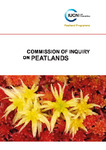IUCN UK Commission of Inquiry on Peatlands.
| dc.contributor.author | Bain, C.G., Bonn, A., Stoneman, R., Chapman, S., Coupar, A., Evans, M., Gearey, B., Howat, M., Joosten, H., Keenleyside, C., Labadz, J., Lindsay, R., Littlewood, N., Lunt, P., Miller, C.J., Moxey, A., Orr, H., Reed, M., Smith, P., Swales, V., Thompson, D.B.A., Thompson, P.S., Van de Noort, R., Wilson, J.D. & Worrall, F., | |
| dc.contributor.other | International Union for the Conservation of Nature | |
| dc.date.accessioned | 2021-08-09T14:56:24Z | |
| dc.date.available | 2021-08-09T14:56:24Z | |
| dc.date.issued | 2011-10-01 | |
| dc.identifier.isbn | 978-0-9570572-1-0 | |
| dc.identifier.uri | http://hdl.handle.net/10026.1/17516 | |
| dc.description.abstract |
Peatlands are areas of land with a naturally accumulated layer of peat. These are formed under waterlogged conditions from carbon rich, dead and decaying plant material. In the UK mosses, mainly Sphagnum species, are the main formers of peat. Peatlands are found in at least 175 countries – from the tropics to the poles – and cover around 4 million km2 or 3% of the world’s land area. In Europe, peatlands extend to ca. 515,000 km2 . The UK is amongst the top ten nations of the world in terms of its total peatland area. The UK has between 9-15% of Europe’s peatland area (46,000-77,000 km2 ) and about 13% of the world’s blanket bog – one of the world’s rarest habitats. There are three main types of peatland in the UK: blanket bogs, raised bogs and fens. The international importance of the peatlands found in the UK give it an especial responsibility for their management and conservation. The IUCN UK Commission of Inquiry on Peatlands has gathered up-to-date knowledge from science, policy and practice. The assessment focuses on blanket bog and raised bog peatlands, because they represent over 95% of all UK peatland habitat and offer an opportunity to make early and substantial progress in delivering a combination of economic, social and biodiversity gains. However, we recognise that lowland, river and groundwater-fed fen peatlands are also vital carbon stores, as well as existing and potential areas of rich biodiversity, which have also been subject to intensive and damaging management. Fen peatlands share many of the issues affecting rain-fed peatlands but with distinct differences in terms of their functions, threats and pressures, which merit further investigation. A multidisciplinary team of experts produced this Report. It provides an authoritative assessment of the available evidence, based on peer-reviewed scientific consensus about the state of peatlands, the impacts of different activities on peatland ecosystems and the services they provide and the benefits of restoring and conserving them. The assessment explores mechanisms and processes for peatland conservation action, recognising the different social, economic and environmental drivers. The evidence-gathering approach was inclusive, engaging individual land managers as well as a wide range of organisations, which in itself has helped to foster joint action for peatland conservation and restoration. The Assessment Report sets out the main conclusions, highlighting gaps and opportunities for further action. It identifies ways to secure additional funding and develop expertise to help land managers restore the UK’s peatlands and to allow decision makers to take better account of their multiple benefits. | |
| dc.format.extent | ? - ? (109) | |
| dc.language.iso | en | |
| dc.publisher | Published by the IUCN UK Peatland Programm | |
| dc.relation.ispartof | Commission of Inquiry on Peatlands | |
| dc.title | IUCN UK Commission of Inquiry on Peatlands. | |
| dc.type | report | |
| plymouth.confidential | false | |
| plymouth.publisher-url | http://www.iucn-uk-peatlandprogramme.org/sites/all/files/IUCN%20UK%20Commission%20of%20Inquiry%20on%20Peatlands%20Full%20Report%20spv%20web.pdf | |
| plymouth.publication-status | Published | |
| plymouth.organisational-group | /Plymouth | |
| plymouth.organisational-group | /Plymouth/Faculty of Science and Engineering | |
| plymouth.organisational-group | /Plymouth/REF 2021 Researchers by UoA | |
| plymouth.organisational-group | /Plymouth/REF 2021 Researchers by UoA/UoA14 Geography and Environmental Studies | |
| plymouth.organisational-group | /Plymouth/Users by role | |
| plymouth.organisational-group | /Plymouth/Users by role/Academics | |
| dc.publisher.place | UK | |
| dc.rights.embargoperiod | Not known | |
| rioxxterms.licenseref.uri | http://www.rioxx.net/licenses/all-rights-reserved | |
| rioxxterms.type | Technical Report |


